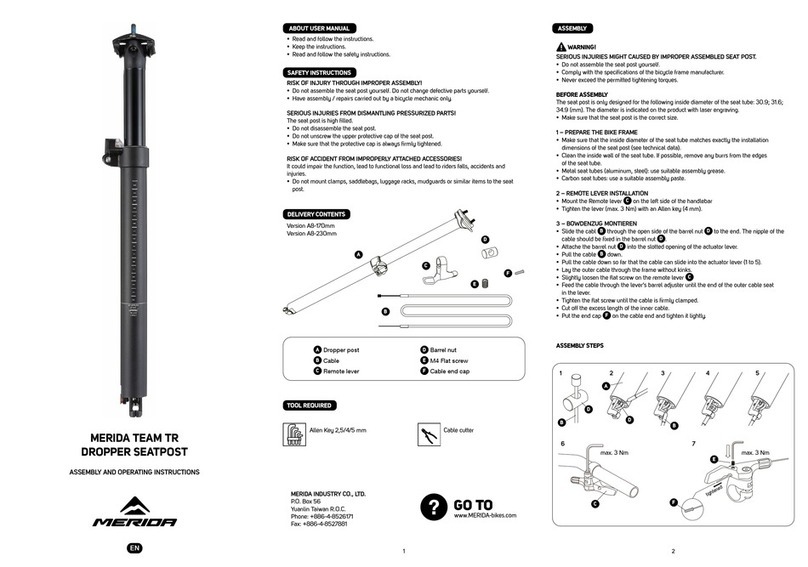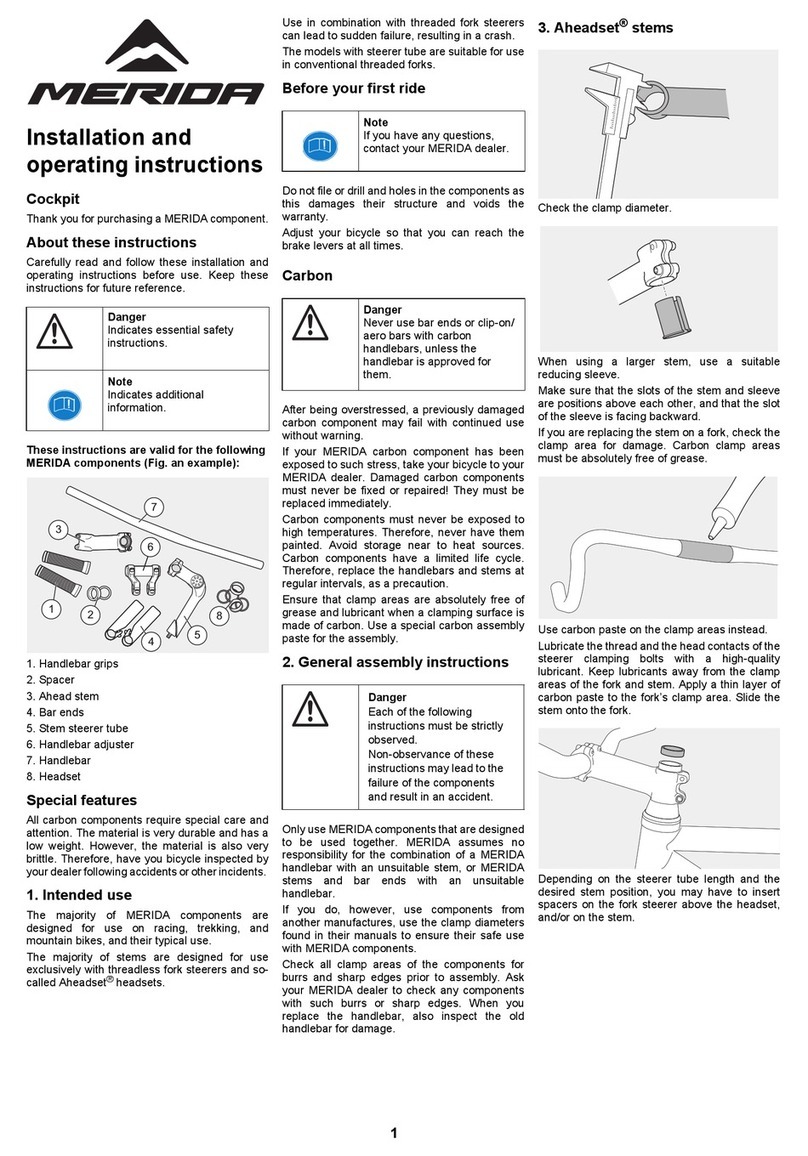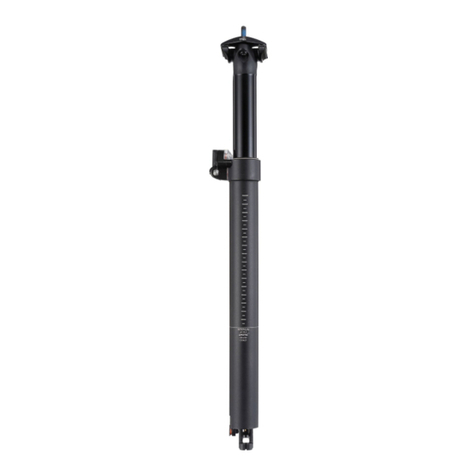Merida Procraft Sattel User manual

Installation and operating
instructions
Saddle/Seatpost
Thank you for purchasing a MERIDA component.
About these instructions
Carefully read and follow these installation and operating
instructions before use. Keep these instructions for future
reference.
These instructions are valid for the following
MERIDA components:
1. Suspension seatpost
2. Reducing sleeves
3. Classic seatpost
4. MERIDA EXPERT CC seatpost
5. Quick release
6. Saddle
Special features
The material is very durable and has a low weight. Have
your bicycle inspected by your dealer following accidents
or other incidents.
1. Intended use
The majority of MERIDA components are designed for
use on racing, trekking, and mountain bikes, and their
typical use.
Before your first ride
Never modify MERIDA components. Do not file or drill
and holes in components as this damages their structure
and voids the warranty.
Only use MERIDA parts with each other to achieve
optimum function and component durability.
Carbon
After being overstressed, a previously damaged carbon
component may fail without warning.
If your MERIDA carbon component has been exposed to
such high stress, take your bicycle to your MERIDA
dealer. For safety reasons, carbon components can
never be repaired and must always be replaced
immediately.
Carbon components must never be exposed to high
temperatures. Therefore, never have them painted.
Avoid storage near to heat sources. Carbon components
have a limited life cycle. Therefore, replace them at
regular intervals, as a precaution.
Ensure that clamp areas of carbon parts are completely
free of grease and lubricant.
2. MERIDA Saddles
Assembly
To mount the saddle, loosen the fixing bolts of the saddle
clamp just a few turns. If the saddle rails are too far apart,
do not force the rails into the clamp grooves.
Position the surface of the saddle parallel to the ground.
Gently tighten the bolts of the saddle clamp. You will find
the next steps in “SETTING THE CORRECT SEAT
POSITION”.
MERIDA EXPERT CC seatpost special features
With this model, the individual components must be
mounted in the correct combination and orientation.
See also “SETTING THE FORE-AFT POSITION AND
TILT OF SADDLE.”
3. MERIDA seatposts
MERIDA seatposts differ mainly in terms of the clamping
mechanism. The diameter of the post and its length are
important – see also “SETTING THE CORRECT SEAT
POSITION” in this regard.
Assembly
The difference between the (greater) internal diameter of
the seat tube and the (smaller) external diameter of the
seatpost should be between 0.05 mm and 0.1 mm.
If necessary, deburr the seat tube.
If a MERIDA aluminum seatpost is mounted in a frame
made of aluminum, titanium, or steel, the inside of the
seat tube must be greased.
With carbon components, the inside of the seat tube and
the post itself must be completely free of lubricants. Use
a special carbon assembly paste for the assembly.
Now slowly slide the post into the seat tube, no farther
than is necessary.
Do not rotate the post in the frame.
Slide the seatpost at least so far that the marking for the
minimum insertion depth (min. insertion, stop, etc.) is
inside the seat tube. For frames with seat tubes that
extend upward, the seatpost may need to be lowered
farther. Refer to the bicycle/frame manufacturer’s
instructions.
Special features of MERIDA EXPERT CC
seatposts
During assembly, make sure that the label “in front” is
pointing in the direction of motion.
Danger
Indicates essential safety instructions.
Danger
Replace the component following
a heavy impact.
Danger
If the component shows external signs
of damage, you should no longer ride
using this component.
Danger
Each of the following instructions must
be strictly observed. Non-observance
of these instructions may lead to the
failure of the components.
Note
The seatpost must glide smoothly into
the frame. However, it must not be
able to tilt back and forth.
1
2
3
4
5
6
Danger
Never mount pannier racks or trailer
coupling on carbon posts.
Flange Yoke (rear ange)
Long boltShort bolt
Direction of motion
Mounting bracket
Note
The seatpost must glide smoothly into
the frame. However, it must not be
able to tilt back and forth.
Note
The seatpost must glide smoothly
into the frame. However, it must not
be able to tilt back and forth.
Danger
If a clamping surface is made of
carbon, neither the frame nor the post
may come into contact with lubricants!
Use a special carbon assembly paste
for the assembly.
in
front
1

4. MERIDA reducing sleeves
for seatposts
Reducing sleeves for seatposts compensate for
differences in diameter between the seatpost and seat
tube in the frame.
If using a metallic frame and seatpost, lubricate the inside
of the frame and the inside of the reducing sleeve before
mounting the seatpost.
If carbon components are involved in clamping, no
grease may be applied there. Use special carbon
assembly paste when clamping carbon components!
Slide the reducing sleeve into the frame so that the slot is
congruent with that of the frame. Then see “MERIDA
SEATPOSTS/ASSEMBLY”.
5. Adjusting MERIDA suspension
seatposts
The suspension seatpost is prepared for a weight of
approx. 75–85 kg. To adjust the suspension, it must be
removed from the frame.
Carefully read the bicycle manufacturer’s user manual,
and follow the instructions in the chapter “MERIDA
seatposts/assembly”.
If the post is too soft, screw in the bolt in a clockwise
direction. The suspension will get harder.
If the post is too hard, screw the bolt counter-clockwise.
The suspension will get softer.
After mounting, check that the post compresses approx.
10 mm when you are sitting in your riding position.
6. Setting the correct seat position
Setting the saddle height
Pedaling determines the required saddle height. The
balls of the big toes should be above the center of the
pedal axle. The leg must not extend fully at the lowest
point of the pedal stroke.
Check the saddle height by sitting on the saddle and
placing your heel on the pedal in the lowest position. In
this position, the leg should be fully stretched. The hips
must remain straight. To adjust the saddle height, you
have to loosen the saddle clamping bolts or the quick
release.
Use a suitable tool to loosen the seatpost clamping bolt,
turning it 2–3 times counter-clockwise. Now slide the
seatpost to the desired position. Obtain a longer seatpost
if necessary. Align the saddle so that it is point straight
ahead again. Tighten the seat tube clamp in half-turns,
and check that the post is held securely by trying to rotate
the saddle. Sufficiently tightening the clamping bolt or
quick release should not require much force.
Setting the fore-aft position and tilt of saddle
For seatposts with 2-bolt yoke clamps, loosen both fixing
bolts and move the saddle forward and backward to the
desired longitudinal position. Then tighten the bolts until
both clamps touch the saddle rails. The brackets should
not clamp, otherwise there is a risk of breakage.
Tightening the front bolt lowers the saddle point, while
tightening the rear one lifts it. If the adjustment range is
not sufficient, loosening the front bolt at the same time as
tightening the rear one will also elevate it. Loosening the
rear bolt and tightening the front one lowers the saddle
point. Retighten the bolts evenly and alternately with a
torque wrench, paying attention to the torque specified
on the component.
MERIDA EXPERT CC seatpost
This MERIDA EXPERT CC seatpost has a weight-
optimized clamp, so the individual components must be
mounted in the correct combination and orientation.
Tighten the bolts of the seatpost.
For seatposts with 1 or 2-bolt patented clamps, loosen
the clamping bolts and move the saddle forward or
backward, or the saddle point up or down.
The clamps may be within the marks on the saddle rails.
The brackets must not clamp on the bends. There is a
danger of breakage.
Now tighten the bolts until both clamps touch the saddle
rails. Increase the torque using a torque wrench until the
maximum torque specified on the component is reached.
7. Handling quick releases
The hand lever transforms the closing motion into
clamping force via an eccentric cam.
The binder nut sets the tension on a threaded rod.
Open the quick release and the text “Open” can be seen.
Move the lever back to the clamping position and the text
“Close” appears. The lever should move easily at first.
During the second half of the movement, the leverage
should increase considerably. Finally, the lever should be
very difficult to move.
In its final position, the lever must be parallel to the
bicycle, resting close to the frame.
Check that it is sitting correctly by pressing on the end of
the closed lever and trying to rotate it.
If the clamping lever moves, the component is not
securely held in place. You will need to open it again and
increase the pretension. To do this, screw the binder nut
on the other side a half-turn clockwise. Repeat the
closing process and check the grip again.
Finally, take hold of the front and back of the saddle, and
try to rotate it.
Note
Read “HANDLING QUICK
RELEASES”. Only tighten the bolt in
the clamp so far/close the quick
release so that the post does not slip
when you are mounting the saddle.
After mounting the saddle, proceed as
described in the chapter “SETTING
THE CORRECT SEAT POSITION”.
Note
Before mounting a suspension
seatpost, follow the setting instructions
in the chapter “ADJUSTING MERIDA
SUSPENSION SEATPOSTS”.
Danger
Seat tube and seatpost diameters that
do not match exactly can cause the
seatpost or frame to break.
Note
Mark the position of the seatpost in the
frame.
Danger
Only unscrew the adjusting bolt
enough so that it sits flush with the
post.
Danger
Never ride a bike where the maximum
seatpost length marking is visible.
Danger
Insufficiently tightened quick releases
can cause components to come loose.
6Nm6Nm
Torque
specication
2

8. Care and maintenance
Clean the components regularly with water and a soft
cloth. For stubborn stains, you can add some readily
available dish soap to warm water. Do not use any harsh
cleaning agents.
Rub the metallic surfaces and carbon with commercially
available hard wax at least two times per year. Polish the
post once the wax has dried.
After cleaning, the plastic saddle cover can be
maintained with a colorless plastic care product (e.g.
cockpit spray).
Mount the component once per year. Grease the parts
again, with the exception of carbon parts.
Maintain the interior of the suspension post every 60–
100 hours of operation/yearly. Replace the grease, and
check seals, guides, and spring elements.
Check the torque values of all bolts after the first 100–
300 km (60–180 miles), and then again every 2,000 km
(1,200 miles).
9. Warranty and guarantee
Statutory warranty rights apply within the first two years.
This regulation only applies in states that have ratified the
EU bill.
The components are subject to natural wear, depending
on use and external conditions.
We also grant a manufacturer’s guarantee on all
MERIDA components (from the date of purchase, to the
first purchaser) of 5 years on material and workmanship.
In case of defects, please contact your MERIDA dealer.
In a guarantee case where the respective higher-quality
model is unavailable, MERIDA INDUSTRY CO., LTD.
reserves the right to deliver the respective current
successor model in the available color.
Assembly and/or conversion costs and any accessories
(due to altered dimensions) will not be refunded in a
guarantee case.
The manufacturer guarantee is only valid for the first
purchaser upon presentation of proof of purchase
showing the purchase date, dealer address, and model
name.
The intended use is a prerequisite for the guarantee. The
guarantee does not cover labor and transportation costs,
or any follow-up costs caused by defects. Competition
use in the context of road races, triathlon, or the MTB
sections of cross-country races are covered by the
guarantee. Other visible fall damage resulting from jumps
or other types of overstress is likewise not covered by the
guarantee. The guarantee does not cover damage
caused by wear, neglect, crashes, overstressing caused
by overloading, improper installation and care, or the
modification of components.
In the interest of a long life and durability of the
components, the manufacturer’s installation instructions
and the prescribed maintenance intervals must be
adhered to exactly. Failure to comply with the installation
instructions and inspection intervals will void the
guarantee.
The upper material of the saddle becomes rough when
exposed to sunlight, and wears out during use due to
mechanical stress. Regular cleaning and care have
a positive impact on wear.
10. Technical specifications
Saddles
Diameter of wires or tubes
of the saddle rails: 7 mm
Reducing sleeves for seatposts
Your dealer will inform you about the diameters available
in the current MERIDA catalog.
Seat posts
Available diameters –
depending on the model: 27.2–34.9 mm
Minimum insertion depth:
The minimum insertion depth is marked on every post.
The marking must always be lowered into the frame.
For the maximum torque of the seat tube clamp, see the
frame manufacturer’s instructions.
Note
When cleaning, pay attention to any
damage to the materials.
Note
If there is any doubt, always adhere
to the values specified on the
component.
If you have any questions, please contact:
MERIDA INDUSTRY CO., LTD.
P.O. Box 56
Yuanlin Taiwan R.O.C.
Phone: +886-4-8526171
Fax: +886-4-8527881
www.merida-bikes.com
5th Edition, February 2017
© No part of this document may be reprinted, translated,
reproduced, or otherwise used, e.g. on electronic media
without prior written consent.
Graphics, text, and design
2W Technische Informations GmbH & Co.KG
www.2wgmbh.de
3
Table of contents
Other Merida Bicycle Accessories manuals
Popular Bicycle Accessories manuals by other brands

Specialized
Specialized Elite CylcoComputer user manual

Sigma
Sigma BC 16.16 manual

Playcore
Playcore Dero Setbacks installation instructions

VDO Cyclecomputing
VDO Cyclecomputing x3dw instruction manual

Cateye
Cateye RAPID X2 manual

buratti meccanica
buratti meccanica Clorofilla Trail Use and maintenance manual














